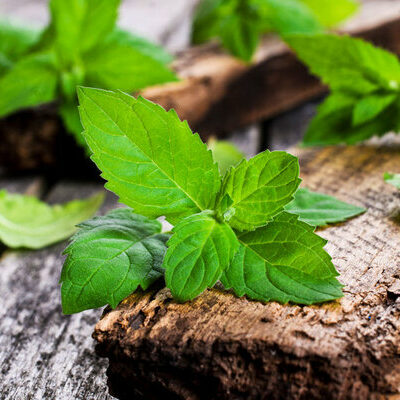
Mint
also known as Mentha
What is Mint?
Mint is an aromatic herb belonging to the Lamiaceae family. There are several different cultivars of edible mint. This plant is grown throughout the world and used in a variety of different cuisines. It is also an invaluable component in various cocktails like the mojito.
- The leaves are usually bright green in color and arranged in opposite pairs.
- This herb provides a strong and fresh flavor that leaves a cool feeling in the mouth.
Some popular ways to use this herb in the kitchen include:
- Tea
- Toppings
- Pesto
- Salad
- Cocktails
- Lemonade
- Garnish
Origin
This herb originated independently in Asia and the Mediterranean regions. Some varieties also developed independently in Australia. The name comes from the Greek mythical character, Mintha, a river nymph who was turned into a mint plant by Persephone because her husband, Hades, fell in love with her.
One of the earliest mentions of this herb is from 1550 BC in the ancient Egyptian Ebers Papyrus, in which it is mentioned as a medicine for indigestion. In several ancient cultures, this herb was an integral part of funeral rites. It continued to be viewed as a medicinal herb till early modern times.
Nutrition
Nutritional profile for this herb (100 gms):

This herb is rich in calcium, iron, magnesium, phosphorous, potassium, sodium, vitamin C, folate, and especially vitamin A. It is considered a medicinal plant due to its various disease prevention and disease curing properties. Regular consumption of this herb may help in reducing the total cholesterol levels, triglycerides, HDL level in the blood.
Essential oil from the herb may help in alleviating pain due to its anti-inflammatory properties. Additionally, it is often used as a digestive due to its cooling properties, and works to relieve problems of the digestive system and respiratory tract system, as well as hemorrhoids. The antioxidants, especially in the variety, M. longifolia, help in cancer prevention. Also, it has antimicrobial, antifungal, antiviral, and antibacterial properties, which help in preventing infections.
Commercial production
Most of the world’s mint production comes from the USA, India, and China. Its cultivation requires a moderately warm climate and a well-drained loamy or sandy loamy alkaline soil with rich organic matter. The crops often yield two harvests per year and the harvesting is usually done on sunny days in order to increase the flavor and menthol content in the leaves.
This herb has a very short shelf life and is usually consumed within a couple of days for best results. If it needs to be stored, it must be kept in the refrigerator wrapped up in paper or plastic bags. Options to store this herb through drying or freezing are also there.
Mint recipes
Mint is extensively used in several cuisines around the world. It is ubiquitously present and is grown everywhere. Here are a few recipes:
- Larb Gai
- Pudina Thogayal
- Nasi Ulam
- Tabouli
- Limonana
- Shai bil Na’ana’a
- Yalanji
- Cacik
- Pesto Spaghetti
- Burrata Agnolotti
- Chocolate Mint
- Omelette à la Menthe
- Mint Chocolate Macarons
- French Pea Soup
- Pudina Rice
- Chicken Tagine
FDA regulations
Mint falls under the spices, other natural seasonings and flavorings category of the Code of Federal Regulations, though only peppermint and spearmint are specifically mentioned. It is classified as a spice, which is defined as any aromatic vegetable substance in whole, broken, or ground form, whose function in food is seasoning rather than nutritional.
References
Mint, National Horticulture Board, Ministry of Agriculture & Farmers Welfare, India, https://www.nhb.gov.in/Horticulture%20Crops/Mint/Mint1.htm
Victoria Pickering, Plant of the Month: Mint, JSTOR Daily, https://daily.jstor.org/plant-of-the-month-mint/
Tafrihi, Majid et al. “The Wonderful Activities of the Genus Mentha: Not Only Antioxidant Properties.” Molecules (Basel, Switzerland) vol. 26,4 1118. 20 Feb. 2021, doi:10.3390/molecules26041118, https://www.ncbi.nlm.nih.gov/pmc/articles/PMC7923432
Mikaili, Peyman et al. “Pharmacological and therapeutic effects of Mentha Longifolia L. and its main constituent, menthol.” Ancient science of life vol. 33,2 (2013): 131-8. doi:10.4103/0257-7941.139059, https://www.ncbi.nlm.nih.gov/pmc/articles/PMC4171855/
